Get Ready for Opening Day
Here's your preseason game plan for a successful start to waterfowling's main event
Here's your preseason game plan for a successful start to waterfowling's main event

By Will Brantley
Our optimism was fueled by about a thousand ducks that we had seen churning one of the river's mud flats the evening before. The only thing between us and that puddle duck paradise was the bluff, and we convinced ourselves that launching a canoe there in the dark was no big deal.
I've always felt that your chances for success on opening day (and throughout the rest of the season, for that matter) are best when you are well prepared and when you give it everything you've goteven if that means rappelling a fully loaded canoe down a precipitous embankment. The journey to a successful opener starts months in advance, and you need a good preseason checklist to make sure you're ready when the big day arrives. With that in mind, use these expert tips to start planning your own countdown to opening day.
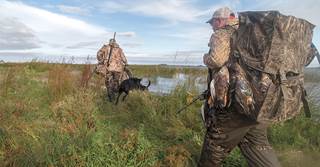
Photo Dean Pearson
It seems clich and even obvious, but Missouri outfitter Eric Rinehart says a don't-let-up mindset can help put more ducks in front of your gun. "You get what you put in, and some people struggle with that," he says. "Having a good spot is important, but the time and effort you put into preparation can matter just as much. You've got to think about duck season sooner than 10 days before it starts. If you want to make the most of your opportunities, you have to make the time to prepare."
The best hunters I know, whether they're chasing elk or teal, are in good physical condition. You don't have to run a marathon, but remember that waders, heavy clothing, and decoy bags can combine with deep mud and shallow water to create a unique blend of physical challenges. I've done a number of high-mountain backcountry big game hunts, but some of my most memorable moments of pure exhaustion happened in the duck marsh. Simply put, if you can't physically get there, then the hunt's over before it even begins. Regular resistance training and cardio exercisewalking, running, biking, or swimmingare critical.

Photo UPCLOSEPHOTO.COM
A normal year finds Ramsey Russell in pursuit of waterfowl across the United States and Canada as well as in Argentina, Mexico, Australia, Azerbaijan, and other far-flung locales. Last year's travel was restricted, but Russell still managed to hunt 160 days in 22 states. His Lab, Char, was with him the whole way. A schedule like that demands extra attention to your retriever. Russell says that Char spends most of her summer with a trainer, working on some specific drills.
"When I showed up at the trainer's last summer, I brought a portable dog blind with me and explained that I wanted that to be her happy place, even if it's set up 50 yards away," Russell says. There are many benefits to a steady dog waiting some distance outside the blind. "Panel blinds are popular right now, but dogs can't see the action if they're sitting inside the blind, and it defeats the purpose if the dog's sitting right outside."
Having Char place-trained to the portable dog blind allows Russell to position her 20 yards off to the side of his blind, or 40 to 50 yards behind a goose spread. It's safer and also more effective. "Being a short distance away from the shooters gives her a better field of view to see birds fall," Russell explains.
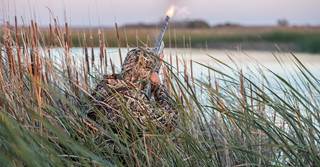
Photo Mossy Oak
Let's face it. Most of us would benefit from some preseason practice at the range. For me, skeet is the best preparation for waterfowl shooting. But you should go about it thinking like a duck hunter rather than worrying about your score. The other day I shot with a couple of guys who took skeet shooting very seriously. They carried custom over/unders with ported barrels, and they premounted them at every station in a deliberate fashion. My score at the end of the day was considerably lower than theirs, but I wasn't there for competition. My goal was to practice with my duck gun. After a few rounds I was reminded once again that the fundamentals of a good mount, a fluid swing, and a little deliberation will help you break more targetsand knock down more ducks too.
To avoid the weekend crowds, shoot during the week after work. Focus on the shots that give you the most trouble. For me, stations three through six are best for practicing sustained leads on crossing birds. The targets at station eightwhich are supposed to be easy but give me fitshelp me prepare for wood ducks flashing through the timber at daybreak.

Photo Ed Wall Media
Do you know what's actually required to brush a blind? Mike Boyd does. He's been guiding duck hunters on Mississippi's famed Beaver Dam Lake for 40 years. Along with his son, Lamar, he hunts the full 60-day duck season, rain or shine. He says the birds are tougher to hunt now than everif they see you, they're gone.
The Boyds hunt from a large blind built into the cypress trees, overlooking one of the lake's storied duck holes. Concealing such a large structure takes considerable time and effort. The work starts in late summer and early fall, ahead of the first frost. "We've got places where young willows have exploded, with a lot of leaves and limbs, and they'll hold their leaves if they're cut before a frost," Boyd says. "We bring in this brush by the trailer load. I'm talking three 16-foot trailers stacked as high as you can get them, with ratchet straps on top to keep it all from coming apart on the drive to the lake.
"We go the extra mile brushing blinds to completely hide their outline," Boyd continues. "And I don't think the average hunter has any concept of how much brush that really takes."
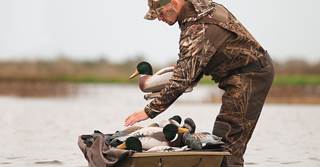
Photo SHARP-EYEIMAGES.COM
Rinehart's southeast Missouri hunting areas receive big pushes of migrating and wintering ducksand a lot of hunting pressure. Huge, permanent spreads are common in that part of the world, but Rinehart picks up his decoys at the end of every hunt. He puts in the extra effort so local birds don't learn to associate his spreads with hunters.
"We put out and pick up 10 to 12 dozen every day," he says. "It doesn't take long with Texas rigs. But your decoys have to look good, so we don't put more than a dozen on each carabiner. We also try not to drag them around, and we place them in the boat as soon as we pick them up, so they don't get covered in mud."
Rinehart says he's the first to make adjustments to his spread if birds aren't finishing, and he might rearrange his decoys half a dozen times to get them just right. "But you should also stick with what works. If you know what the ducks want to do under certain conditions, set up for that. Don't change things up just to try something new. We make notes on what worked last year under various weather patterns. We know how ducks like to work our blinds on south winds and west winds, and we plan accordingly."
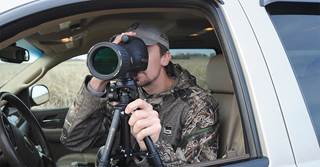
Photo Jim Thompson
If I were asked to choose the most overlooked piece of waterfowl hunting gear, it would be a good pair of binoculars. On big rivers and reservoirs, especially, being able to identify ducks on the water without flushing themand also being able to scope out potential hiding spotscan make all the difference.
Jeremy Dersham, operator of Ridge and River Running Outfitters, guides duck hunters on the Upper Mississippi River. He says that many waterfowlers are tempted to hunt the largest concentrations of ducks they can find, but smaller groups of birds sitting in the right places will often provide better hunts. "Sometimes I'm perfectly happy to find a few dozen ducks in a group, loafing in a little oxbow where I can hide," he says. "At the end of the day you can only shoot so many. When I'm scouting, I look at the wind, where I can conceal myself, and where I can get a few groups of ducks to commit for good shooting opportunities. I don't need to chase the huge rafts of birds."
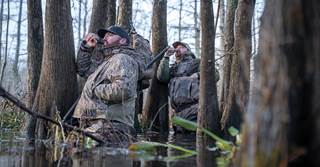
Photo Ed Wall Media
Logan Hancock hails from Monticello, Arkansas. At age 32 he became one of the youngest callers ever to win the World's Championship Duck Calling Contest in Stuttgart three times. It comes as no surprise that Hancock hunts public timber, where good calling can mean the difference between full straps or going home empty-handed. But Hancock doesn't expect everyone who hunts with him to be a competition-level caller. "If you listen to live ducks for more than five minutes, you'll notice that some are raspy and others are whiny," Hancock says. "And to sound like a raft of ducks in the timber you need a lot of people blowing a call."
That's why Hancock doesn't worry much about the varying skill levels of other callers in his hunting party. "The idea that one of your buddies sounds so bad that he's flaring ducks... I don't know that I believe that," he says. "A buddy of mine in competition calling, Nick Johnson, put it like this: 'Figure out what your group can do, and then let them do it.' If you've got a kid who can do a quack or a feed call, let him do it. You fill in the gaps where you're needed, and together it will sound pretty good."
Hancock adds that duck hunting is more fun when everyone gets a chance to call. "As long as you're not blowing hail calls at birds on their final approach, we're good!" he laughs.

Photo Michael Clingan
Just about every duck season my buddies and I notice that we need new decoy bags. The drawstrings have been broken for a decade, and one of them has a hole in the bottom just big enough for the teal decoys to slip out. Like many hunters, we do a good job of maintaining our shotguns, waders, decoys, and boats, but we often overlook the little stuff.
Traveling the world as he does, Ramsey Russell considers thoughtful packing to be an art form. And he packs light. "It sounds corny but make a list of what you need before you head to camp," he says. "Personally, I can't relate to the guys who need new clothes every day on a hunting trip. I lay my one set of hunting clothes out in layers, plus an extra pair of underwear and socks, and whatever I'm wearing to travel. Much more than that is overpacking. But you need to carefully choose the things you really need, because that makes you more comfortable. I wear leather shooting gloves, for example, and it takes about 24 hours for them to dry when they get wet. So I always pack two pairs."

Photo Todd J. Steele
Ryan and I listened to the meeps of trading gadwalls in the soft morning light. And shortly after the first legal minute, it was apparent that we were in for a "gray duck day." Flocks of gadwalls locked up hard 150 yards out and then slipped away just out of rangeonly to circle and do it again. We called and we stayed quiet and we laughed and cussed. We finished a few flocks and scratched out some birds, but we didn't limit out as we'd hoped to.
And we still had to deal with the canoe and the bluff. This time Ryan pushed from below while I pulled the rope from above, wrapping it around trees to stop and rest as we made our ascent. I peeled off a coat and then a fleece. Finally at the truck and down to a base layer, I tossed Ryan a bottle of water. We guzzled and caught our breath and I said, "I'm sorry this sucked."
"What are you talking about?" Ryan gasped. "We have all season left, and I've got two ducks to pluck for the grill tonight."
Indeed, waterfowling is always best when you've given it everything you have.
Ducks Unlimited uses cookies to enhance your browsing experience, optimize site functionality, analyze traffic, and deliver personalized advertising through third parties. By continuing to use this site, you agree to our use of cookies. View Privacy Policy